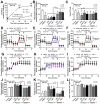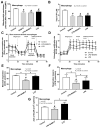Sepsis Encephalopathy Is Partly Mediated by miR370-3p-Induced Mitochondrial Injury but Attenuated by BAM15 in Cecal Ligation and Puncture Sepsis Male Mice
- PMID: 35628259
- PMCID: PMC9141734
- DOI: 10.3390/ijms23105445
Sepsis Encephalopathy Is Partly Mediated by miR370-3p-Induced Mitochondrial Injury but Attenuated by BAM15 in Cecal Ligation and Puncture Sepsis Male Mice
Abstract
BAM15 (a mitochondrial uncoupling agent) was tested on cecal ligation and puncture (CLP) sepsis mice with in vitro experiments. BAM15 attenuated sepsis as indicated by survival, organ histology (kidneys and livers), spleen apoptosis (activated caspase 3), brain injury (SHIRPA score, serum s100β, serum miR370-3p, brain miR370-3p, brain TNF-α, and apoptosis), systemic inflammation (cytokines, cell-free DNA, endotoxemia, and bacteremia), and blood-brain barrier (BBB) damage (Evan's blue dye and the presence of green fluorescent E. coli in brain after an oral administration). In parallel, brain miR arrays demonstrated miR370-3p at 24 h but not 120 h post-CLP, which was correlated with metabolic pathways. Either lipopolysaccharide (LPS) or TNF-α upregulated miR370-3p in PC12 (neuron cells). An activation by sepsis factors (LPS, TNF-α, or miR370-3p transfection) damaged mitochondria (fluorescent color staining) and reduced cell ATP, possibly through profound mitochondrial activity (extracellular flux analysis) that was attenuated by BAM15. In bone-marrow-derived macrophages, LPS caused mitochondrial injury, decreased cell ATP, enhanced glycolysis activity (extracellular flux analysis), and induced pro-inflammatory macrophages (iNOS and IL-1β) which were neutralized by BAM15. In conclusion, BAM15 attenuated sepsis through decreased mitochondrial damage, reduced neuronal miR370-3p upregulation, and induced anti-inflammatory macrophages. BAM15 is proposed to be used as an adjuvant therapy against sepsis hyperinflammation.
Keywords: BAM15; cecal ligation and puncture; extracellular flux; sepsis; uncoupling agent.
Conflict of interest statement
The authors declare no conflict of interest.
Figures










Similar articles
-
BAM15, a Mitochondrial Uncoupling Agent, Attenuates Inflammation in the LPS Injection Mouse Model: An Adjunctive Anti-Inflammation on Macrophages and Hepatocytes.J Innate Immun. 2021;13(6):359-375. doi: 10.1159/000516348. Epub 2021 Jun 1. J Innate Immun. 2021. PMID: 34062536 Free PMC article.
-
Interference on Cytosolic DNA Activation Attenuates Sepsis Severity: Experiments on Cyclic GMP-AMP Synthase (cGAS) Deficient Mice.Int J Mol Sci. 2021 Oct 23;22(21):11450. doi: 10.3390/ijms222111450. Int J Mol Sci. 2021. PMID: 34768881 Free PMC article.
-
Plasma miR-370-3P as a Biomarker of Sepsis-Associated Encephalopathy, the Transcriptomic Profiling Analysis of Microrna-Arrays From Mouse Brains.Shock. 2020 Sep;54(3):347-357. doi: 10.1097/SHK.0000000000001473. Shock. 2020. PMID: 31743302
-
miR-34b-3p protects against acute kidney injury in sepsis mice via targeting ubiquitin-like protein 4A.Kaohsiung J Med Sci. 2020 Oct;36(10):817-824. doi: 10.1002/kjm2.12255. Epub 2020 Jul 1. Kaohsiung J Med Sci. 2020. PMID: 32609950 Free PMC article.
-
Cecal ligation and puncture sepsis is associated with attenuated expression of adenylyl cyclase 9 and increased miR142-3p.Shock. 2011 Oct;36(4):390-5. doi: 10.1097/SHK.0b013e318228ec6f. Shock. 2011. PMID: 21701418
Cited by
-
Lipopolysaccharide Tolerance Enhances Murine Norovirus Reactivation: An Impact of Macrophages Mainly Evaluated by Proteomic Analysis.Int J Mol Sci. 2023 Jan 17;24(3):1829. doi: 10.3390/ijms24031829. Int J Mol Sci. 2023. PMID: 36768154 Free PMC article.
-
Polymeric Particle BAM15 Targeting Macrophages Attenuates the Severity of LPS-Induced Sepsis: A Proof of Concept for Specific Immune Cell-Targeted Therapy.Pharmaceutics. 2023 Nov 28;15(12):2695. doi: 10.3390/pharmaceutics15122695. Pharmaceutics. 2023. PMID: 38140036 Free PMC article.
-
Less Severe Sepsis in Cecal Ligation and Puncture Models with and without Lipopolysaccharide in Mice with Conditional Ezh2-Deleted Macrophages (LysM-Cre System).Int J Mol Sci. 2023 May 10;24(10):8517. doi: 10.3390/ijms24108517. Int J Mol Sci. 2023. PMID: 37239864 Free PMC article.
-
Less Severe Polymicrobial Sepsis in Conditional mgmt-Deleted Mice Using LysM-Cre System, Impacts of DNA Methylation and MGMT Inhibitor in Sepsis.Int J Mol Sci. 2023 Jun 15;24(12):10175. doi: 10.3390/ijms241210175. Int J Mol Sci. 2023. PMID: 37373325 Free PMC article.
-
Lacticaseibacillus rhamnosus dfa1 Attenuate Cecal Ligation-Induced Systemic Inflammation through the Interference in Gut Dysbiosis, Leaky Gut, and Enterocytic Cell Energy.Int J Mol Sci. 2023 Feb 13;24(4):3756. doi: 10.3390/ijms24043756. Int J Mol Sci. 2023. PMID: 36835163 Free PMC article.
References
MeSH terms
Substances
Grants and funding
LinkOut - more resources
Full Text Sources
Medical
Research Materials
Miscellaneous

